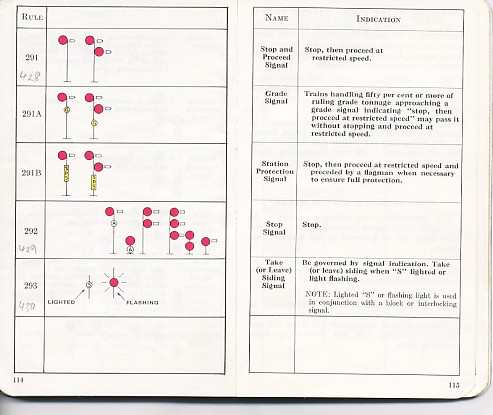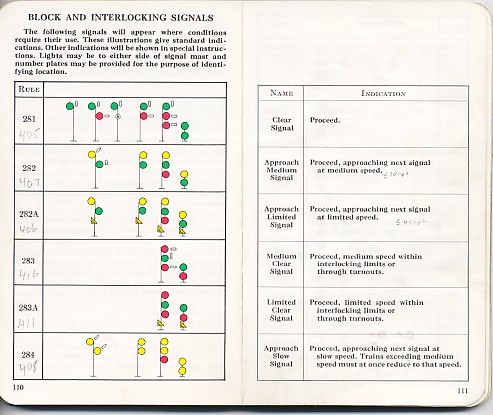01-22-2010, 01:59 AM
I posted this on the old forum.
These are pages out of the previous edition of the Canadian Rules book, I think from just after the end of steam. Each indication has a rule number and employees are expected to know them.
As an example of ingenuity, if a bulb is burned out the signal must be interpreted at its most restricting possibility; I think this means assuming the bulb is red.



Note that the signals say nothing about routes; only about speeds. Some indications can be given with 1, 2, or 3 signal heads while others require all 3. Rules with 2 or 3 heads are usually at interlockings or yard approaches. 2 heads on the same side of the post are interlocking while 2 on opposite sides are block signals. (but see rules 287 and 288)
Also note the rules with letters on plates on the posts.
These are pages out of the previous edition of the Canadian Rules book, I think from just after the end of steam. Each indication has a rule number and employees are expected to know them.
As an example of ingenuity, if a bulb is burned out the signal must be interpreted at its most restricting possibility; I think this means assuming the bulb is red.
Note that the signals say nothing about routes; only about speeds. Some indications can be given with 1, 2, or 3 signal heads while others require all 3. Rules with 2 or 3 heads are usually at interlockings or yard approaches. 2 heads on the same side of the post are interlocking while 2 on opposite sides are block signals. (but see rules 287 and 288)
Also note the rules with letters on plates on the posts.
David
Moderato ma non troppo
Perth & Exeter Railway Company
Esquesing & Chinguacousy Radial Railway
In model railroading, there are between six and two hundred ways of performing a given task.
Most modellers can get two of them to work.
Moderato ma non troppo
Perth & Exeter Railway Company
Esquesing & Chinguacousy Radial Railway
In model railroading, there are between six and two hundred ways of performing a given task.
Most modellers can get two of them to work.



 hock:
hock: